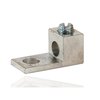Circular lugs usually have a circularly-shaped hole in a block of aluminum, with a screw piercing at a right angle to the circular hole, and squeezing down into the wire. It has the advantage that the screw actually separates the strands and squeezes them against the circular wall of the aluminum block, thereby enlarging the contact area between wire and lug/screw, as well as increasing the local force on the wire strands, which also improves the contact area (because copper is somewhat malleable). A've attached a picture of an uncaptured lug from my electrical panel that's UL-rated for 00 to 4 AWG wire, a pretty wide range of wire size. Other similar lugs are rated for 6 to 14 AWG, also a pretty wide range of wire size.View attachment 509244
But the Wall Connector supports 15A to 100A !!



